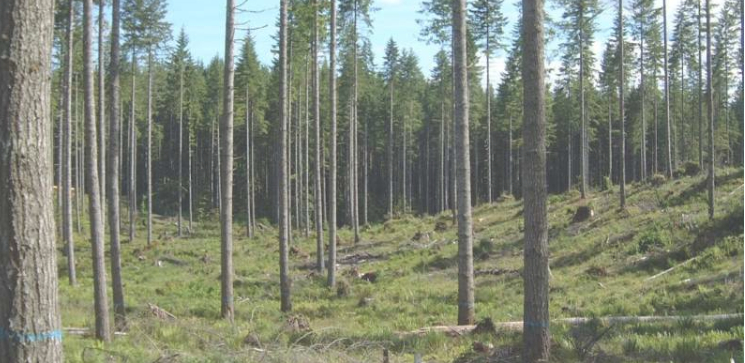June 16, 2025 | 23:15 GMT +7
June 16, 2025 | 23:15 GMT +7
Hotline: 0913.378.918
June 16, 2025 | 23:15 GMT +7
Hotline: 0913.378.918

Forest-harvesting practices that retain living trees throughout the harvested area sustain belowground life. Credit: John L. Innes, Author provided
In a single teaspoon of forest soil there are thousands of species and billions of individual organisms. These include microorganisms such as bacteria and archaea, soil animals like the microscopic protozoa, nematodes, tardigrades, collembolan and mites, and larger fauna such as millipedes, centipedes and worms.
A cubic centimeter of forest soil can also harbor more than a kilometer of fungal hyphae, the mass of thread-like cords running through the soil and forming mycelia.
This astonishing diversity of belowground life is arranged into complex food webs, with many of the larger animals feeding on smaller animals and microorganisms. This complex network has been largely ignored in forest management, but could be a key ally in making our forests resilient to stresses imposed by global climate change.
All life belowground ultimately relies on plants for nourishment. Some soil organisms feed on dead leaves and roots, which they transform into soil organic matter. This matter is critical for soil fertility and water retention, and is the primary reservoir for soil carbon.
Other belowground organisms rely on the simple sugars released from the roots of living trees to survive and grow. In tree needles and leaves, atmospheric carbon dioxide is converted into sugars and other metabolites via photosynthesis.
Up to half of the sugars produced in leaves are conveyed belowground to tree roots. A portion of these sugars are exuded from root tips or transferred to mycorrhizal fungi that live in and around the roots.
Mycorrhizal fungal hyphae extend from root tips further into the soil and also exude sugars and metabolites. These compounds support abundant soil microorganisms and form the basis of a vast food web belowground.
Within hours or days of carbon dioxide being taken up by tree leaves, some of the carbon is released from roots and fungal hyphae and distributed throughout the belowground food web.
The dead bodies of, and metabolites released by, the soil microorganisms are also an important source of soil organic matter.
This new appreciation of the importance of living roots in sustaining life belowground should prompt us to rethink forest management.
Harvesting trees severs the critical flow of resources belowground, directly reducing the abundance and diversity of soil life. However, harvesting practices that retain living trees within 15 meters of each other, can maintain soil life throughout the harvested area.
Forest harvesting practices that retain a portion of the living trees, such as continuous cover forestry and retention forestry can help keep the soil alive in harvested forests.
Plant diversity also matters, as species differ in the variety of compounds released by their roots, which influences microbial diversity in the soil.
Soil biodiversity can be promoted by establishing forests with more than one tree species. In particular, forests that contain broadleaf tree species and tree species with nitrogen-fixing microbial associates promote soil biodiversity and replenishment of soil organic matter.
In the face of the twin crises of climate change and biodiversity collapse, we need forests that are resilient and diverse. Soil organisms are critical allies in this endeavor.
Soil organisms contribute half of the biodiversity of forests and regulate the processes that govern soil fertility, water retention and greenhouse gas emissions. Forestry practices that foster soil biodiversity can assist in making our forests resilient and diverse.
The vital role of inputs from living roots for sustaining soil organic matter and belowground life has been recognized in agriculture and is a central principle of regenerative agriculture, a suite of practices that actively restore soil quality, biodiversity, ecosystems health and water quality while producing sufficient food of high nutritional quality.
Forestry could also be regenerative, particularly if we apply practices such as continuous cover and species mixtures, and intentionally conserve life belowground.
(The Conversation)

(VAN) Extensive licensing requirements raise concerns about intellectual property theft.

(VAN) As of Friday, a salmonella outbreak linked to a California egg producer had sickened at least 79 people. Of the infected people, 21 hospitalizations were reported, U.S. health officials said.

(VAN) With the war ongoing, many Ukrainian farmers and rural farming families face limited access to their land due to mines and lack the financial resources to purchase needed agricultural inputs.

(VAN) Vikas Rambal has quietly built a $5 billion business empire in manufacturing, property and solar, and catapulted onto the Rich List.

(VAN) Available cropland now at less than five percent, according to latest geospatial assessment from FAO and UNOSAT.

(VAN) Alt Carbon has raised $12 million in a seed round as it plans to scale its carbon dioxide removal work in the South Asian nation.

(VAN) Attempts to bring down the price of the Japanese staple have had little effect amid a cost-of-living crisis.